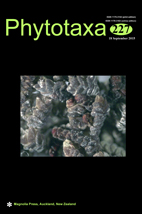Abstract
Several diatoms in the family Achnanthaceae (Bacillariophyta), mainly from marine environments, have species with strongly apiculate, lemon-shaped valves. Some of them originally described under the genus Cocconeis (i.e., C. trachyderma or C. citronella), while others were first described as Stauroneis species [i.e. Stauroneis apiculata or S.(?) obesa]. Afterwards, Cocconeis citronella has been recombined within Achnanthes by Hustedt. The type material of C. citronella from Albert Mann’s collection, housed in the Smithsonian Institution (US), has been examined with light microscope; some ambiguities are pointed out and new details added to the original description. The intricate history of the latter taxon is redrawn and comparison with allied taxa are tentatively addressed. Cocconeis trachyderma is lectotypified and recombined as Achnanthes trachyderma comb. nov. Stauroneis apiculata and S.(?) obesa are recombined as Achnanthes apiculata comb. nov. and Achnanthes obesa comb. nov. respectively. The examination with light and scanning electron microscope of several marine samples from the Society Archipelago details the unique morphology of Achnanthes trachyderma which, until recently, has been often misidentified as Achnanthes citronella due to certain similarities between both taxa.

